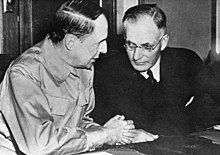Curtin government
Curtin government | |
|---|---|
 | |
| In office | |
| 7 October 1941 – 5 July 1945 | |
| Monarch | George VI |
| Prime Minister | John Curtin |
| Deputy | Frank Forde |
| Party | Labor |
| Status | Minority (1941–1943) Majority (1943–1945) |
| Origin | Predecessor lost confidence motion |
| Demise | Curtin's death |
| Predecessor | Fadden government |
| Successor | Forde government |
| ||
|---|---|---|
Term of government (1941–1945)
Ministries
Elections |
||
The Curtin government was the federal executive government of Australia led by Prime Minister
Background
John Curtin was first elected leader of the Australian Labor Party and became leader of the opposition in 1935. Defence issues were becoming increasingly dominant in public affairs with the rise of Fascism in Europe and militant Japan in Asia. Curtin led Labor to the 1937 election against Joseph Lyons' United Australia Party which resulted in a comfortable victory to the UAP. Lyons died in office in April 1939 and the UAP selected Robert Menzies to succeed him as Prime Minister.[1]
On 3 September 1939, Prime Minister Menzies announced Australia's declaration of war on
Curtin took a seat on the newly created Advisory War Council in October 1940 and agreed to a plan by Menzies to travel to Washington and London.
In Office
Curtin led Australia when the Australian mainland came under direct military threat during the Japanese advance in World War II. He is widely regarded as one of the country's greatest Prime Ministers.[6] General Douglas MacArthur said that Curtin was "one of the greatest of the wartime statesmen".[7]
With most of Australia's best forces committed to fight against Hitler in the Middle East, Japan attacked Pearl Harbor, the US naval base in Hawaii, on 8 December 1941 (eastern Australia time). The British battleship HMS Prince of Wales and battlecruiser HMS Repulse sent to defend Singapore were sunk soon afterwards. Australia was ill-prepared for an attack, lacking armaments, modern fighter aircraft, heavy bombers, and aircraft carriers. While demanding reinforcements from Churchill, on 27 December 1941 Curtin published an historic announcement:[8]
"The Australian Government...regards the Pacific struggle as primarily one in which the United States and Australia must have the fullest say in the direction of the democracies' fighting plan. Without inhibitions of any kind, I make it clear that Australia looks to America, free of any pangs as to our traditional links or kinship with the United Kingdom."[9]
British Malaya quickly collapsed, shocking the Australian nation. British, Indian and Australian troops made a disorganised
Two battle-hardened Australian divisions were already steaming from the Mid-East for Singapore. Churchill wanted them diverted to Burma, but Curtin refused, and anxiously awaited their return to Australia. US President


In an effort to isolate Australia, the Japanese planned a seaborne invasion of Port Moresby, in the Australian Territory of New Guinea. In May 1942, the US Navy engaged the Japanese in the Battle of the Coral Sea and halted the attack. The Battle of Midway in June effectively defeated the Japanese navy and the Japanese army launched a land assault on Moresby from the north.[8] Between July and November 1942, Australian forces repulsed Japanese attempts on the city by way of the Kokoda Track, in the highlands of New Guinea. The Battle of Milne Bay in August 1942 was the first Allied defeat of Japanese land forces.
Concerned to maintain British commitment to the defence of Australia, Prime Minister Curtin announced in November 1943 that
The
As the end of the war approached, Curtin sought to firm up Australian influence in the South Pacific following the war but also sought to ensure a continuing role for the
In April 1945, Curtin despatched an Australian delegation which included attorney-general and minister for external affairs
Death of Curtin
Prime Minister Curtin suffered from ill health from the strains of office. He suffered a major heart attack in November 1944. Facing the newly formed
When Curtin died towards the end of the
See also
- History of Australia
- History of Australia since 1945
- First Curtin Ministry
- Second Curtin Ministry
- Chifley government
References
- ^ http://primeministers.naa.gov.au/primeministers/lyons/after-office.aspx [bare URL]
- ^ a b c "Before office - John Curtin - Australia's PMS - Australia's Prime Ministers". Archived from the original on 13 July 2017. Retrieved 24 April 2011.
- ^ http://primeministers.naa.gov.au/primeministers/fadden/in-office.aspx Archived 24 August 2011 at the Wayback Machine [bare URL]
- ^ "Curtin, John (1885–1945)". Australian Dictionary of Biography. National Centre of Biography, Australian National University.
- ^ http://primeministers.naa.gov.au/primeministers/curtin/elections.aspx [bare URL]
- ^ "John Curtin". Australia's Prime Ministers. National Archives of Australia. Archived from the original on 26 July 2010. Retrieved 29 June 2010.
- ^ General Douglas MacArthur, Reminiscences, Heinemann, London, 1967. Page 258.
- ^ a b c d "In office - John Curtin - Australia's PMS - Australia's Prime Ministers". Archived from the original on 17 January 2012. Retrieved 23 April 2011.
- ^ Cited in Frank Crowley (1973) Vol 2, p.51
- ^ "Midget Submarines history at". Home.st.net.au. Archived from the original on 13 April 2010. Retrieved 29 April 2010.
- ^ "Gloucester, first Duke of (1900–1974)". Australian Dictionary of Biography. National Centre of Biography, Australian National University.
- ^ "Evatt, Herbert Vere (Bert) (1894–1965)". Australian Dictionary of Biography. National Centre of Biography, Australian National University.
- ^ "Francis Forde – Australia's PMs – Australia's Prime Ministers". Archived from the original on 26 July 2010. Retrieved 23 April 2011.
- ^ Chifley, Joseph Benedict (Ben) (1885–1951) Biographical Entry – Australian Dictionary of Biography Online

